18 Hidden News Gems That Emerged From April's Tech Vendor Earnings Calls

As much of the spring tech vendor earnings season is behind us, it's time to look deeply at what executives actually said on their quarterly calls. Doing this usually will unearth interesting storylines that didn't make headlines, but are freighted with potential significance. In many cases, the stories behind the stories are the most interesting ones.
Oftentimes executives will say things on earnings calls -- particularly during the deliciously unrehearsed format of a Q&A -- that point to larger issues. Sometimes it's what they don't say that carries the most meaning. Basically, there's lots of interesting stuff in earnings calls, provided you listen closely enough.
CRN listened to the earnings calls of Amazon, VMware, EMC, Microsoft, Google, Intel, Citrix, Apple and Juniper Networks, which all took places in early to late April. Here, we present two stories from each vendor's earnings calls that mattered most.
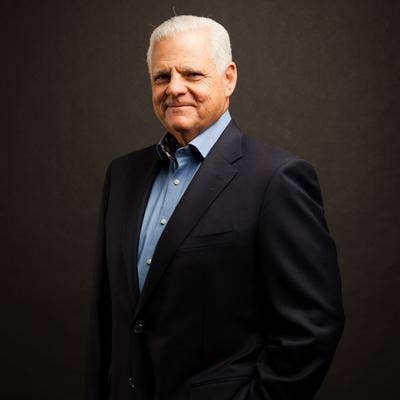
EMC
1. Will Tucci Stay On At Dell Technologies?
On EMC's earnings call, a Wall Street analyst asked a question that was surely on everyone's minds: whether CEO Joe Tucci plans to stay on in some capacity once Dell completes its acquisition of EMC.
"To me, this is all about making sure it's a good deal for our customers, our shareholders and our people, and they're all priority No. 1 to me," Tucci responded, in case anyone thought that one of the tech industry's most respected leaders didn't have his business priorities straight.
But then, Tucci suggested that he'd like to stay on at Dell Technologies in some sort of advisory role. "I have a lot of energy left, I'm going to continue to work doing different things. [There is the] potential that I could help advise Michael [Dell], but I just don't want to go there yet, and Michael and I have not gone there yet," said Tucci.

2. Not Much Talk About Virtustream Cloud Business
EMC set tech industry tongues wagging last May when it plunked down $1.2 billion to acquire cloud infrastructure startup Virtustream, even though it already had VMware's vCloud Air cloud infrastructure services as part of its federation of companies. On EMC's earnings call, Virtustream didn't get much love, aside from a new cloud storage service, which had some partners wondering, "Wait, how exactly is this better than Amazon and Microsoft Azure cloud storage?"
EMC did report that demand for its Virtustream Enterprise Cloud jumped more than 50 percent during its first quarter and that more customers were moving mission-critical workloads into its cloud. However, after EMC and VMware's failed efforts to combine Virtustream with vCloud Air, there are still more questions than answers about whether Virtustream was worth the money that EMC spent.

3. Amazon CFO To Wall Street: Yes, We Had A Nice Operating Margin, Don't Get Used To It
Amazon Web Services is doing so well that Amazon CFO Brian Olsavsky actually had to warn Wall Street analysts not to extrapolate even greater numbers from this quarter's results, in which AWS generated a 23.5 percent operating margin. That was up from 12.4 percent during last year's quarter.
"I would caution you that we're pleased, but it is very early to start drawing too many conclusions on the long-term margins in this business -- they'll be bumpy over time," Olsavsky said in response to one analyst's question.
What he meant: As Amazon continues to build out its global cloud infrastructure, and cuts its pricing for cloud services, some quarters may see less gaudy operating margin numbers.

4. Amazon Web Services Is Now $10 Billion Business, Says CFO
Amazon just reported the most profitable quarter in its 22-year history. Its cloud arm, Amazon Web Services, generated around 60 percent of Amazon's $1 billion-plus operating income, despite producing just 9 percent of its overall revenue. That's kind of ridiculous and takes a while to get your head around.
But then there's this: AWS sales grew 64 percent year over year and the unit has generated $8.7 billion in sales in the past four quarters. And Amazon CFO Brian Olsavsky said on the call that AWS is now a $10 billion business, but like all Amazon executives, he said this in a way that made it clear that no one is popping the champagne corks just yet. Amazon is relentless and its ethos is all about never looking back to gloat on past successes.

5. VMware Sics VSAN On Unsuspecting Hyper-Convergence Market
EVO:Rail, VMware's bizarrely named first foray into the hyper-convergence market, didn't have much impact. But now, giddy from the release of its VSAN 6.2 software-defined storage technology, VMware is once again making noise about being a leader in the space.
VSAN, which pools storage from server hard drives and makes it available to virtual machines, is a key part of VMware's hyper-convergence strategy, CEO Pat Gelsinger said on the vendor's earnings call. "VMware is a leader in hyper-converged infrastructure software, having sold to more than 3,500 customers in 21 months since the initial release of Virtual SAN [in 2014]," said Gelsinger.
VMware's hyper-converged portfolio consists of vSphere server virtualization, vCenter Server and VSAN. It remains to be seen whether customers embrace the technology en masse, but early returns suggests this approach is working a lot better than the old one.
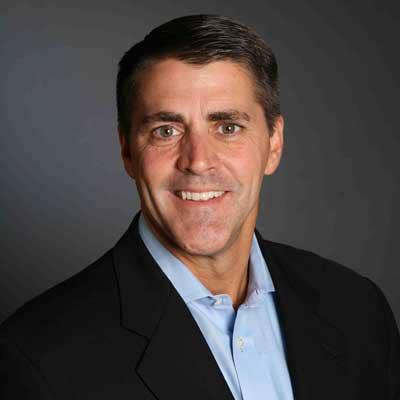
6. Gelsinger: Eschenbach Is Still A 'Rainmaker' For VMware ELAs
Carl Eschenbach (pictured), VMWare's chief operating officer and one of the top salespeople in enterprise software, departed in March to join Silicon Valley venture capital firm Sequoia Capital. Eschenbach was particularly good at helping VMware close huge, multiyear software contracts known as enterprise licensing agreements, as well as renewing these deals.
Although Eschenbach's absence isn't ideal, Gelsinger said on the vendor's earnings call that VMware's ELA and renewal business is still strong. "We remain quite comfortable with our ability to close ELAs," Gelsinger said on the call. "We do have a very large ELA renewal opportunity this year. ... In the second half it's [a] very large opportunity."
Maurizio Carli, an eight-year VMware veteran who was overseeing the Americas region, has been named to take on some of Eschenbach's previous responsibilities as executive vice president of worldwide sales. Eschenbach is still working with VMware in an advisory capacity, and Gelsinger described him as "a rainmaker for us" in that role.

Microsoft
7. Microsoft's Patent Licensing Declines As Cheap Android Devices Flourish
Microsoft's patent licensing revenue dropped 26 percent during its latest quarter. The company attributed it to a "decrease in total unit volume and a higher mix of lower royalty units." Translation: Low-cost Android device makers are flooding the market with cheap smartphones, and most of these companies don't have patent licensing deals with Microsoft.
Microsoft has long asserted that Android violates its Linux patents, and it regularly strikes licensing deals with Android vendors who pay up because they've got no interest in battling Microsoft in court. However, this was the third straight quarter in which Microsoft's patent licensing revenue has declined, so the cheap Android phenomenon has got to be a concern for the software giant.
Further complicating matters is Microsoft's ongoing push to cast itself as a lover of Linux and all things open source. This is no empty pledge -- Microsoft has made a number of surprising and meaningful moves on the server and cloud computing side that suggest it has changed its stance on open source. Yet as long as the Android patent lawsuits continue, there will be skeptics who question Microsoft's motives for embracing open source.
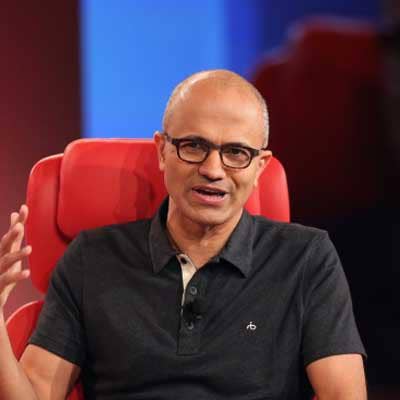
8. Nadella Says Office 365 E5 Plan Still In Early Innings
Microsoft CEO Satya Nadella said last July that the top-end Office 365 E5 service stands to open up $50 billion in additional market opportunity, but so far sales don't seem to be moving the needle much.
"We're in the very early innings of E5, but the value proposition and the total addressable market ... is huge, and so we remain very excited about it," Nadella said in response to a Wall Street analyst's question about sales momentum.
Office 365 E5, which hit the market in December, includes everything but the kitchen sink: Productivity software, security, business intelligence, IP telephony and advanced analytics are all part of the mix. But at $35 per user monthly -- or $420 annually -- E5 is a big jump from the $22 per user monthly that customers have been paying for the E4 service.
That could change in July when Microsoft discontinues the E4 offering, at which point customers that use this version will either have to upgrade or downgrade. No vendor is better than Microsoft at using licensing to drive customer behavior, but what it's doing with Office 365 E5 is ambitious to say the least.

9. Cloud Machine Learning The Key To Enterprise Traction
Google is coming late to the cloud party and has lots of catching up to do on market leaders Amazon Web Services and Microsoft Azure.
But Google is confident that its vast experience running search and developing massive-scale technologies will eventually give it the upper hand. One example is Cloud Machine Learning, which Google unveiled at a cloud conference in March, along with its Cloud Vision API and Cloud Speech API.
"At Google, machine learning is already helping us improve our products every day in search and many other areas like photos, maps and more," CEO Sundar Pichai said on the vendor's recent earnings call.
AWS and Microsoft also offer cloud machine learning services, and this space is fast emerging as the next big battleground for cloud vendors.
Pichai said Google's cloud machine learning can help "enterprises really understand their data, understand how best they can do what their core competency is and really revolutionize around that. It's early days and it's a long-term investment," he said on the call.
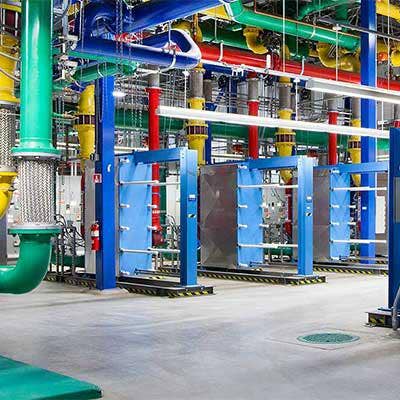
10. Google Fiber Still On Slow Rollout Timetable
Google Fiber thus far seems to have millions of people who would love to subscribe, if only for a chance to tell Comcast, Time Warner and other service providers to take a hike. But Google Fiber is available in only 22 U.S. markets, so the excitement around the service is understandably tepid in areas outside the coverage zone.
Google CEO Ruth Porat said on the call that Google's current focus is on "increasing throughput" for existing customers and markets. "Our vision here is to create abundant and ubiquitous networks. We think there's a lot of opportunity to improve the experience that users have, and that's where the Fiber team is focused."
Reading between the lines, it doesn't look like Google is ready for the kind of broad national expansion that could give incumbents some much-needed pricing and service quality competition.
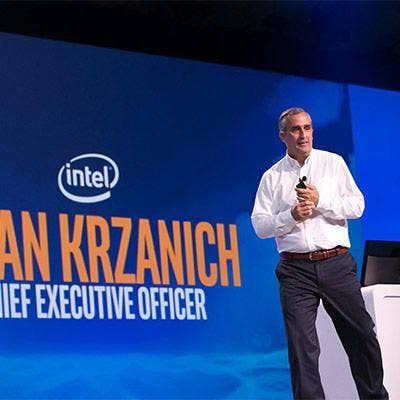
Intel
11. Intel CEO Says PCs Are Still A Thing
Intel CEO Brian Krzanich just presided over a quarter in which the company beat Wall Street's earnings forecast but shed some 12,000 jobs, largely in response to the dwindling demand for PCs. Yet Krzanich is still confident that PCs will continue to be a viable business for Intel.
When one Wall Street analyst asked whether the PC market might contract to the point where Intel would have to rethink its manufacturing process, Krzanich shot down the idea.
"No, I'm not worried that PC will shrink to a point where the scale will get large enough to fund either the factories or the other innovations," said Krzanich on the call. The restructuring, he said, will redirect resources to the areas of the PC market that are growing.
"You're going to see more investments in 2-in-1s. You're going to see more investments in thin-and-light devices. You're going to see us push even harder on high-end gaming systems, which are growing at a very fast rate," Krzanich said. "We're continuing to gain share in segments like set-top boxes, which are becoming more and more PC-like in their capabilities."

12. Rack Architecture Is Intel's Ace In The Hole
When a Wall Street analyst asked Krzanich how Intel plans to stay competitive in a server market where companies are increasingly building their own hardware, he said Intel's strategy goes beyond just the CPU.
"What we are trying to do is really provide top-of-rack to bottom-of-rack solutions that ... work together and bring performance across the whole rack," said Krzanich.
Intel's Rack Scale Architecture lets customers "build racks in a much denser and lower-cost way" than silicon photonics for communications between servers in a rack, he said. In other words, Intel believes its performance will continue to trump that of the competition.
"We are uniquely positioned to provide that whole-rack viewpoint and have everything work together, and come together to bring, really, performance that is just unbelievable," said Krzanich.

Citrix
13. Tatarinov Gives Channel High-Five In First Call As Citrix CEO
Former Microsoft executive Kirill Tatarinov took over as Citrix CEO in January, and this was his first earnings call in his new role. Citrix had a solid quarter, and Tatarinov said a lot of it had to do with clearer marketing and the vendor's renewed focus on channel partners.
"As we simplified our portfolio and sharpened our message, it made it easier for our sellers and channel partners to execute and deliver," Tatarinov said on the call. "The refocus and restructuring is producing not only bottom line results, it's also driving revenue growth."
Tatarinov said Citrix's channel "plays a hugely important role in our future success," although partners who've been watching the vendor's behavior in recent years might not agree.
Citrix's revamped channel strategy includes a "program that encourages acceleration of customer adds and growth in the business, essentially rewarding our channel partners for doing more of that," said Tatarinov on the call.

14. XenApp's Resurgence
Several Wall Street analysts asked Citrix executives on the call why the XenApp product saw solid results during the quarter, when it hadn't done so in previous quarters. Sales of standalone XenApp licenses jumped 10 percent year over year, while cloud service provider subscriptions to XenApp grew 30 percent compared to last year.
Tatarinov said Citrix has invested in making the XenApp product better. "It’s absolutely a technology refresh cycle," he said of XenApp. "There was a massive engineering effort conducted over the last few years, [which] resulted in this highly scalable, highly performing solution."
Windows 10's march into the enterprise is also fueling XenApp, which lets customers continue using their legacy enterprise apps in the new OS, said Tatarinov.
"We're seeing ... many large customers ... looking at XenApp and XenDesktop as a very significant important infrastructure for them to roll out Windows 10 in the enterprise," Tatarinov said on the call.
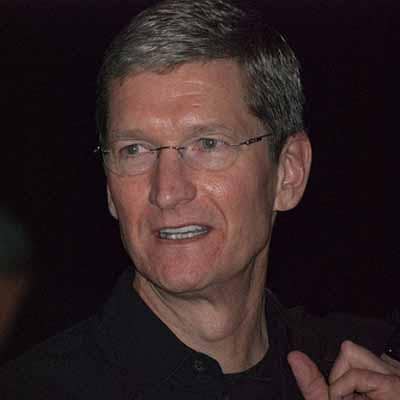
Apple
15. Apple CEO Tim Cook: Lots Of People Switching From Android
Apple just reported its first quarterly revenue decline in 13 years. Apple sold 51.2 million iPhones during the quarter, but that was down from the 61.1 million it sold during last year's quarter, so of course some investors got freaked out and dumped shares of the still-insanely profitable company.
Investors accustomed to seeing consistently great numbers seemed convinced that this was not just a bump in the road, but a full-blown sign that Apple's best days are behind it.
Yet Apple CEO Tim Cook, in his customarily placid style, insisted that the sky wasn't actually falling with regard to iPhone sales. Apple, he said, saw "a very high level of customers switching to iPhone from Android and other operating systems" during the quarter.
"In fact, we added more switchers from Android and other platforms in the first half of this year than any other six-month period ever," Cook said on the call.
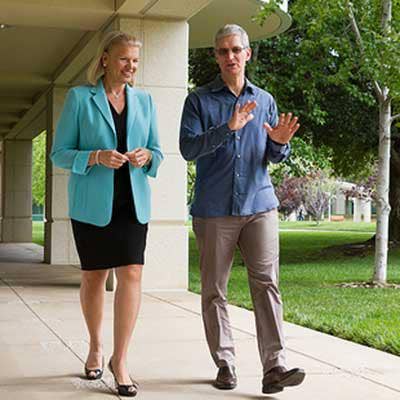
16. Apple Doesn't Talk Much About Enterprise
Apple has in recent years inked partnerships with IBM and Cisco Systems, in part to help it figure out how to form deeper relationships with enterprise customers. In early May, Apple inked a similar deal with SAP. Who says the enterprise tech business isn't exciting?
The thing is, Apple doesn't talk much about these enterprise partnerships. On the call, CEO Cook said IBM is working on "more than 200 deployments of native iOS apps for large enterprise customers," but didn't mention the Cisco relationship.
Sources told CRN last month that Apple's IBM partnership is going swimmingly. Apple bought $67 million in products and services from IBM last year and is on track to buy $82 million this year, said the sources. In general, Apple appears to have subscribed to IBM's all-in-one strategy of deploying cloud, storage and analytics together to solve business challenges.

Juniper Networks
17. CEO Rahim Says Security A Tough Sell During Quarter
Juniper's security business had a "tough quarter" and the vendor is going through "several product transitions" that dampened demand for some of its older SRX security products, CEO Rami Rahim said on the earnings call.
"I have said before that as we grow this area of our business, we expect it to take time and be a bit bumpy along the way," Rahim said. "But I feel good about the long-term road map we're executing on and the confidence that we are building with our customers and partners. Security remains an important part of the solutions we sell to our customers."
In December, Juniper acknowledged a vulnerability in its ScreenOS firewall operating system that could have let hackers decrypt VPN connections. Later, a document provided by whistleblower Edward Snowden indicated that the U.S. National Security Agency worked with its British counterpart, GCHQ, to exploit vulnerabilities in Juniper NetScreen firewalls.

18. Juniper Was Impacted By New ERP System Growing Pains
Juniper, like many other tech vendors have experienced over the years, dealt with the heavy lifting of switching to a new enterprise resource planning system during the quarter. But unexpected challenges associated with the switch-over led to delays in billing customers, said CEO Rahim during the earnings call.
The new ERP system went live in January, but the switch resulted in delays to "order processing and shipment linearity" during the quarter, said Rahim on the call.
These issues are on track to be solved sometime this quarter, and in the long run, Rahim said the new ERP system will benefit the vendor.
"As is typical with ERP implementations of this magnitude, the stabilization of the new processes and system will take several months. We are confident that the system implementation will result in productivity improvements and efficiencies as we move forward," Rahim said.